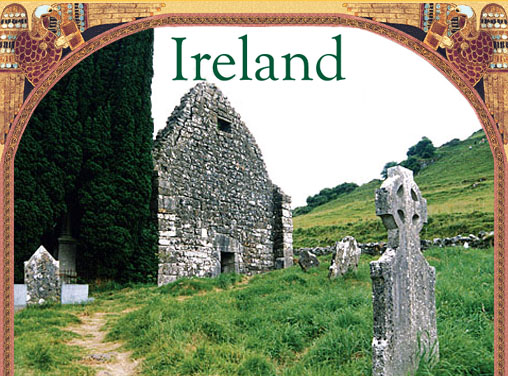|
|
|
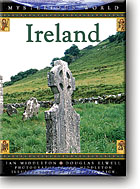
|
|
|
This article is adapted from
Mysterious World: Ireland,
the first in a series of guidebooks published by Mysterious World Press.
Click here to take a journey to visit mysterious Ireland!
|
|
 ost people know that Ireland is one of the most popular tourist destinations in the world, but not everyone knows that it is also one of the most mysterious. When asked about the most mysterious vacation destinations around the world, most people might answer Egypt, or China, Australia, New Zealand, South America, or a variety of other places around the world. And though these locations certainly have their share of ancient mysteries to discover and explore, most of their mystery lies in the fact that they are far away from us, far from the enlightened, rational West, in places where what little technology and civilization exist form a perilously thin skin over traditional lifeways and ancient superstitions that still hold fast.
ost people know that Ireland is one of the most popular tourist destinations in the world, but not everyone knows that it is also one of the most mysterious. When asked about the most mysterious vacation destinations around the world, most people might answer Egypt, or China, Australia, New Zealand, South America, or a variety of other places around the world. And though these locations certainly have their share of ancient mysteries to discover and explore, most of their mystery lies in the fact that they are far away from us, far from the enlightened, rational West, in places where what little technology and civilization exist form a perilously thin skin over traditional lifeways and ancient superstitions that still hold fast.
Many of our articles in Mysterious World, however, have proven this belief to be mistaken. As we have discovered, many of the greatest mysteries of the world are actually to be found in the "civilized" countries of the West, lying undiscovered or forgotten amongst the vast mountains and rolling prairies, enormous amounts of which still lie undeveloped and largely undisturbed between the superhighways that connect the glittering cities and bind the natural world in a web of asphalt and concrete.
Moreover, the "two-thirds world" (a fashionable and more accurate term than "the third world" that better describes the majority of the world that is still largely enslaved by a toxic blend of superstition, poverty and barbarism) has become in recent years increasingly dangerous to visit, to the point where large areas of the earth are effectively off-limits to all but the most daring of travelers. It is primarily for this reason that we at Mysterious World have spent the majority of our time researching the many mysterious travel destinations to be found in the West, many of which may literally be in your own back yard! And of all of the western nations, we have found that the tiny island of Ireland has come out in front as the best combination of mysterious and tourist-friendly, more friendly in some ways than even the United States. Moreover, Irish and Celtic culture has become increasingly popular throughout the West, St. Patrick's Day becoming almost universally celebrated throughout the U.S., Canada, and several other western countries. For these reasons, we decided to make Ireland the subject of the first volume in our new Mysterious World Travel Guides series.
Mysterious World: Ireland has been a labor of love spanning several years and enormous amounts of research, writing and, most of all, travel. More than just a travel guide, Mysterious World: Ireland is a complete guide to Irish history, mythology, and culture designed to give you a more complete understanding of Ireland so you can better appreciate the countless travel destinations to be seen and experienced throughout the sacred isle.
The book will be a great help to anyone trying to
plan a holiday
in Ireland
And so you can "try before you buy", we have decided to publish excerpts from the book in order to give you a flavor of the kinds of treasures that can be found therein. So read on, and join experienced travel writer Ian Middleton on his journey to rediscover mysterious Ireland!

 Hello, my name is Ian
Middleton. Here�s me
standing outside
of my favorite
place to stay
when in Ireland:
Kirwan House in Wexford,
County Wexford. I am a
travel writer based in southern
England, but I have
traveled the world, writing
travel books and articles
about my many adventures.
However, my favorite place to visit, and write about, is
Ireland � my home away from home.
Hello, my name is Ian
Middleton. Here�s me
standing outside
of my favorite
place to stay
when in Ireland:
Kirwan House in Wexford,
County Wexford. I am a
travel writer based in southern
England, but I have
traveled the world, writing
travel books and articles
about my many adventures.
However, my favorite place to visit, and write about, is
Ireland � my home away from home.
One fateful day two years ago whilst surfing the
Internet looking for travel sites and related things of
interest, I stumbled across this amazing website called
Mysterious World (http://www.mysteriousworld.com).
Ostensibly a travel site, it actually includes a great deal
more historical and mythological information than I
am used to seeing in a travel site. I found the site fascinating
and, as a travel writer always on the lookout
for someone to write for, I contacted the publisher
straightaway with an idea I had about writing a series
of articles on traveling in Ireland.
Doug Elwell, the publisher, got back to me fairly
quickly, reacting to my initial email enquiry with
some interest. However, instead of just a series of articles
on Ireland, he suggested that we make an entire
book out of it, and call it
Mysterious World: Ireland,
the first in a series of travel guides. �That�s a great
idea!� I replied, and a book was born.
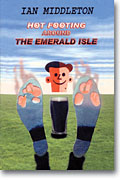
|
Mind you I had already written
a pretty good book about
some of my travel adventures in
Ireland (Hot-Footing It around
the Emerald Isle, available at
http://www.schmetterlingproductions.co.uk), but what Doug
had in mind was not a simple
travelogue, but a huge, rollercoaster
of a travel guide, covering
the entire island, crammed
with all types of travel, historical
and mythological information, with some hot gypsies
thrown in (well, maybe not so many gypsies). He wanted
to cover not only the superficial, touristy side of
Ireland (as other travel guides do), but explore absolutely
everything to do with Irish history, religion and
mythology � everything that makes Ireland Ireland.
My contribution to the project would be the travelogue
& travel info portion, covering all 32 counties and several
islands, that would make up the lion�s share of the
book. However, like Mysterious World�s online journal
(http://www.mysteriousworld.com/Journal/), the book
would also include some very substantial sections that
Doug would write on the historical and mythological
backgrounds of the many places that I would be visiting
throughout the island.
When Doug gave me my itinerary, I noticed that
he had retained the old practice of dividing Ireland
into four provinces � Leinster, Munster, Connaught
and Ulster � in his planning. Though only used
informally now, the use of the four ancient provinces
into which Ireland originally had been divided by
the Fir Bolg in ancient times helped to recall the
ancient past that we were attempting to rediscover,
as many of the stories behind these locations are still
inextricably tied to the provinces in which they
occurred. Interestingly, he also pointed out that I
needed to travel clockwise around the island, as the
ancient Irish believed that moving in that direction
brought good luck. Moreover, moving anti-clockwise
would actually bring bad luck. Why not? I
thought, thinking that perhaps Doug was a little
superstitious himself.
My part of the book was to be called �The
Journey�, which was about my journey to rediscover
the ancient, mysterious side of Ireland that has slowly
but surely been disappearing in the face of
encroaching modernization. And in my research I
discovered that numerous ancient archaeological
sites and even
Tara,
the heart of ancient Ireland, are
right now in real danger of being seriously compromised,
damaged, or even destroyed to make way for
such things as superhighways. As such, the current
government of Ireland�s legacy to future generations
may well be the obliteration of their ancient past,
just so commuters can shave a few minutes off their
morning drive.

|
I then realized that the real importance on this
project was not only to create a travel guide that
actually had some depth to it, but to
draw attention to the plight of that
part of Ireland that is slowly disappearing
� the raths, the stone circles,
the megaliths � the very history
of the land itself. Ireland is not just
about leprechauns and pots o� gold � it
is a country with an ancient history
richer than most in the civilized West,
a history that needs to be cherished
and protected.
With this in mind I piled all my usual travel gear
into the �Mystery Machine� (aka, the �Scooby Van�,
my name for a well-used Bedford Midi camper conversion
that I have been using for the last couple of
years for trips like this) and headed for Fishguard on
the west coast of Wales to cross the Irish Sea on the
ferry, arriving in Rosslare, southeast Ireland after only
a few hours. The great thing about the ferry is that I
can take my camper and everything across, saving the
hassle (and cost) of flying, and of renting a car (which
can get expensive). I can even use it to sleep in when
funds are low, which I did frequently, as we shall see.
I finally made my way to Kirwan House in
Wexford Town, �the last homely house� as I like to
call it, from where I have begun many adventures.
The year was 2004, and it was the fifth year I had
been to Ireland. In that time I must have notched up
over two years spent traveling or living in this country.
I knew it well, or so I thought.
As I sat resting in the TV room, I picked up a copy
of the South East Voice newspaper sitting nearby, and
this headline jumped out at me: �Mysterious Circle
Appears in Joe �Boy� Conboy�s Back Garden�. I read
on. It told how local man Joe had awoken one morning
to find this mysterious circle. Many theories were
suggested by other locals, (the most comical being
from a farmer who claimed to have been abducted by
Martians for eleven hours, warning that �they� were
up to their old tricks again. Part of me couldn�t help
wondering if this was inspired by one too many pints
of Guinness.) However, one quote really caught my
eye: �It was the work of the fairies�.
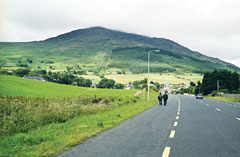
|
As I sipped my coffee I began to think more about this side of Ireland.
It�s a land
aglow with stories,
ancient myths and legends: from fairies to leprechauns,
from the ancient gods to the legendary
giants. Many stories of great battles and magical tales
have their origins here, and many are famous around
the world. It was becoming evident that I had experienced
many wonderful things in this green land, yet
this, the most significant part of Ireland, I had overlooked.
It was time to put that right.

My journey in search of mysterious
Ireland took me first to the current seat
of Ireland: Dublin, in County Dublin,
in Leinster province. Naturally this was
the best place to start my journey, or so I had thought.
I had decided to start at the National Museum of
Ireland in order to get a good overview of Irish history
and culture. This well-maintained building proved to be
an excellent start in my journey, if only to point out
how little I truly knew about the history of the island I
had come to love. As I wandered through the echoing
halls, I was greeted by row after row of sacred history
laid out in neatly defined spaces, each room full of
ancient artifacts yearning to tell me their secrets.
Caught in the moment, I had nearly forgotten that I
had come here on a mission. Fumbling with my camera
in front of one of the more impressive displays full of
golden treasure, I was startled by an odd little man who
suddenly sprang out from behind one of the displays,
almost as if he had come out of nowhere.
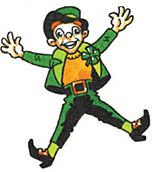
�I�m terribly sorry, you can�t take photos of the artifacts,�
said the little man, who turned out merely to
be a short, rather rotund security guard. Then, as if
sensing my discomfort, he peered upwards at me
apologetically through his large glasses. Disappointed,
I replied, �But I�m doing research for a travel guide to
Ireland about the myths and legends and ancient history
of the country.� I secretly hoped this would
appease him so I wouldn�t be forced to overpower him
and stuff his unconscious body inside the replica of
the passage cairn we were standing next to.
�Well, the problem is there is a copyright on the
artifacts and you will need permission. If you give me
a moment, I�ll see if we can get it.� With a twinkle in
his eyes, he then scuttled off to parts unknown, returning
almost as soon as he had left. Unfortunately he
said I could not have the special permission, so I put
away my camera and continued the tour. As I stood in
front of the Tara exhibit the security guard walked up
and apologized once again. Though I hadn�t thought
of it at the time, he had really gone out of his way to
help me, but I wouldn�t realize until later why.
The museum is actually divided up into four facilities, three of which, the Decorative Arts & History
Museum, the Archaeology & History Museum, and the
Natural History Museum are in Dublin town and the
fourth, the Country Life Museum, is in Castlebar,
County Mayo, far off into the west. Today I was in the
Archaeology & History Museum, which hosts an
impressive array of artifacts from all periods. In the corner
was a 15-meter dugout canoe found in a bog near
Tuam, County Galway. It�s one of the longest found in
Europe and made from a hollowed-out oak tree. Dated
around 2500 BC, it illustrates how Ireland�s first inhabitants
lived and moved around the waterways.
|
|
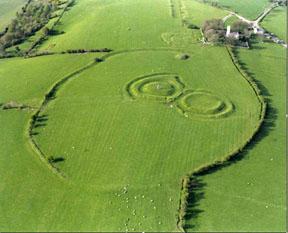
|
|
|
The Hill of Tara, the ancient seat of kingship and the center of Irish history, religion and mythology for thousands of years. The sanctity of Tara is currently under threat as a large new motorway is being built nearby, despite protestations from every sector of society.
Click here
to learn more about how to help save this enormously important landmark from further defilement. Image �
SaveTaraValley.com.
|
|
Next to
this was an example of how the next wave of inhabitants,
the Neolithic people, left behind a legacy of
megalithic tombs which feature largely in Ireland�s legends
and folklore. But what intrigued me most was a display
of the pivotal point of Ireland�s mysterious and spiritual
past: The Hill of Tara. I realized then and there
that this was to be where my journey would truly begin.
The display is a scale model of Tara�s two main hills
and of the surrounding hillsides. It is said that the site
was abandoned in the 6th century AD, but up until then
it had been the seat of the High Kings of Ireland and the
location for some of Ireland�s most famous battles. And
though the political seat of Ireland is now Dublin,
Ireland�s ancient, spiritual seat was, is and always will be
Tara � the heart of Ireland�s mysterious past.
Before my journey to rediscover mysterious Ireland
had begun, I had only been aware of the tales of fairies,
leprechauns and the other superficial silliness normally
portrayed in movies and TV. I had no idea that tales of
warrior races with magical powers, cataclysmic battles
between good and evil and tribes of giants roaming the
land were also an important part of Ireland�s legendary
past. It seems that there is much more to this island�s
history than just funny little men guarding pots of gold.

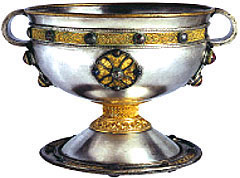
|
|
The �Ardagh Chalice,� the crown jewel of the National Museum
of Ireland. Image courtesy National Museum of Ireland.
|
The large quantities of Bronze Age weapons on display
were recovered from lakes and rivers across the country,
suggesting that they were offerings to the gods. Along
with it are hoards of gold and silver brooches and many
silver chalices, the most magnificent being the Ardagh
Chalice from the 8th century. The chalice had been discovered
around 1868, buried in the southwestern side of
a rath (ring fort) near the village of Ardagh in County
Limerick. It was found by a young man digging for potatoes,
believing that the ring was magical and therefore
protected from the potato blight that had caused the
Great Famine. Dated to the 9th century AD, the chalice
is considered to be the finest example of Celtic
craftsmanship in existence today. The chalice is bronze,
overlaid with gold and silver, and carved with La T�ne-inspired
Celtic ornamentation highly reminiscent of
The Book of Kells. The techniques employed to create
this magnificent chalice include engraving, casting, filigree,
cloisonn� and enameling, indicating a level of
artisanship rarely seen in the ancient world. In other
words, this pot of gold is truly worth guarding.

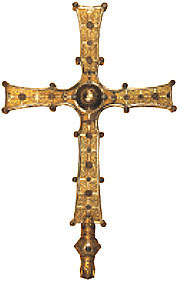
|
|
|
The Cross
of Cong.
Image
courtesy
National
Museum
of Ireland.
|
|
The most famous Christian relic
on display is The Cross of Cong. This cross is composed
of solid oak, 30 inches tall and 19 inches
wide, covered with plates of bronze and silver. Parts
of the cross are also covered with gold, including
gold filigree work of a superlative quality. The Cross
of Cong had been commissioned by King Turlough
O�Connor of Connaught, and it is believed to have
been completed and presented to the king in 1123.
It is believed that the cross was later donated to
Cong Abbey by the O�Duffy clan, where it was put
on display during Christmas and Easter for many
years. It is also believed that a piece of The True
Cross is contained within this sacred artifact.
Another famous Christian artifact is The Tully
Lough Cross. The Tully Lough Cross is an Irish altar
cross believed to date back as early as the 8th century.
The cross was originally found in pieces close to
the edge of a crannog (artificial island) in Tully Lake,
County Roscommon, and is the only known Irish
example of an encased wooden cross.

Nearby was an Ogham stone. Ogham is the earliest
known form of writing in Ireland. The term �ogham�
comes from �Ogma�, the name of one of the tribal
deities of the Tuatha d� Danann, whom they credited
with teaching them the skill of writing, as well as all
the other arts and sciences. The Book of Ballymote,
compiled in AD 1300 records this, and over 300
Ogham inscriptions can still be found all over the
country, mostly in the south. In fact, there are over
eighty of them in County Kerry alone.
Most of these stones are simply inscribed with personal
names and are believed to be either commemorative
or boundary markers. There is even mention in The
T�in saga of C� Chulainn, the hero of the tale, using
Ogham stones to mark his boundaries during battle.

Upstairs I found a Viking exhibition. On display were
the remains of a Viking warrior buried with his sword,
and a vast collection of Viking weapons, pottery and
coins with the image of a Viking king named Sitric.
There were various clashes between the Vikings
and the kings of Ireland, which led me on to the
medieval exhibition. In ancient times Ireland had
been divided into five separate kingdoms: Meath,
Leinster, Munster, Connaught and Ulster. Nowadays
they form the four provinces, with Meath (from the
Gaelic midhe, meaning �middle�) having become
part of Leinster. Each province was ruled by a
provincial king, who answered to the High King
who ruled from Meath for most of Ireland�s known
history. The last High King of Ireland was Ruaidhri
� Conchobhair, who died in 1183. After this, only
the provincial kings and petty kings remained until
kingship was finally wiped out. Petty kings, or tribal
chieftains as they were often referred to, ruled over
small settlements or clusters of agricultural land.

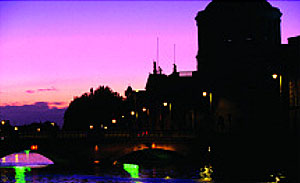
|
|
Four Courts and the O'Donovan Rossa Bridge in Dublin. Dublin
has superb restaurants, bars and nightlife, set in a romantic Old
World milieu. Image � Doug McKinlay/Lonely Planet Images.
|
|
It was evening and the museum was closing, so I
took a leisurely stroll along the Liffey. Dublin actually began as
two Gaelic settlements, later being expanded into a
major port city by the Vikings. Its original name was
�tha Cliath, �The Ford of the Hurdle Work�, named
after an ancient ford that once crossed the River Liffey.
The city�s modern Irish name is Baile �tha Cliath. It�s
believed that a settlement here goes back to prehistoric
times, but it was first documented in the 5th century.
�Hurdle work� probably refers to wooden wattles that
were once used to cross the river at low tide.
The early settlement was on a ridge overlooking
the river crossing, and a monastery was founded near
the tidal pool of the River Poddle, a tributary of the
Liffey. The area around the monastery thus was named
Dubh Linn, �Black Pool�. Much of Dublin�s history is
actually based around the time of the Vikings, who
apparently had changed the pronunciation
from Dubh Linn into Dyflinn, as this
is the name found in the Viking
sagas wherever �Dublin� is meant.

I wandered along the Liffey to an
area called the Merchant�s Quay, and
spotted the Brazen Head pub, with a
sign underneath that said it was the oldest
pub in Ireland. Inside, the barman explained that the
area around Merchant Quay and Wood Quay is the site of the original settlement established by King Turgesius.
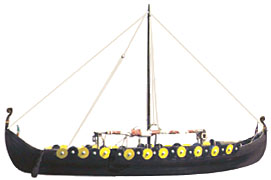
|
|
The Dyflin, a reconstructed Viking ship
based upon the �Gokstad ship�, a
Viking burial ship found in 1880
in Sandefjorde in Norway.
The Gokstad ship, which
has been dated to AD 850,
was probably the tomb of
the Westfold King Olav
Gierstada, the Westfold possibly
being an ancient Viking
designation for Ireland. The
Dyflin, named after the old Norse name for
Dublin is seaworthy, and may be seen in and around Dublin harbor.
The Dyflin was prominently featured in the
documentary, In Search of Ancient Ireland.
|
|
�Is this really the oldest pub in Ireland?� I asked.
�Yes.� he replied, and went on to explain that the
Brazen Head was an old coaching inn from 1688, and
it actually stands on the site of a 12th-century tavern.
Nowadays they no longer do accommodation, but
they have a restaurant and two bars: old and new. The
old bar was once used as an escape route for Robert
Emmet, who planned the 1803 rising while staying
here. It�s said that the bar could be moved back to
allow him escape through a tunnel underneath. He
took me upstairs and showed me the original writing
desk used by Robert Emmet, situated in what is now
the restaurant, and also some engraving on the window
said to have been done by him also.

I finished my drink and wandered up the road. On the
way I passed Dublinia, which was created by the
Medieval Trust as a sort of living museum to Dublin�s
medieval history. The name �Dublinia�
comes from a Latin derivation of the city�s
name after the Anglo-Norman invasion.

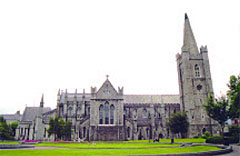
|
|
|
St. Patrick�s Cathedral, Dublin
|
|
St. Patrick�s Cathedral was just up the road. This is
one name that was familiar to me. You would have to
be deaf, dumb and foolish to have traveled Ireland
and not heard of St. Patrick. He is Ireland�s Patron
Saint, and credited with just about everything associated
with the coming of Christianity in Ireland. It is
said that St. Patrick himself converted the local chieftain,
MacEchold, to Christianity. Many monasteries
and schools were set up around what was then a relatively
unimposing cluster of settlements, and the
town began to grow from there. Patrick used to baptize
Christian converts at a well on the site where the
cathedral now stands. The present cathedral dates
from the 12th century, but there has been a monastery
on this spot as early as the 5th century.
I had read that there is a cross carved into a stone at
the northwest corner of the cathedral, which marks the
site of the well, but I couldn�t see anything around the
walls. I found the main entrance around the corner and
wandered in. There is a small charge for entry, but
when I arrived a service was due to begin shortly. As I
poked my head through the door, a man came over.
�Are you here for the service?� he asked.
�No, I�m writing a guide to ancient Ireland and
I�ve heard about a cross-inscribed stone here that
marks the spot of St. Patrick�s Well. Could you tell me
where it is?�
He directed me inside to the northwest corner,
explaining that there were two ancient stones there.
�But please be quick, the service will begin shortly,�
he said.
I tiptoed over. Two large, granite slabs lay horizontally
on stands. The larger of the two is engraved with two
crosses, the top being a large, encircled Celtic cross. A
sign nearby explained that this stone was found buried
nine feet beneath the ground at the site of St. Patrick�s
Well. So, it appeared my information was wrong. The
second carved stone was slightly smaller, and also was
unearthed in the grounds. It is believed to have marked
the grave of one of the earliest Irish Christians. Both
stones were found in 1901, and in all there are six of
these stones inside the cathedral. A total of thirty-two
of these stones have been found in Dublin, and it�s
believed that they were carved sometime between AD
800 and 1100.

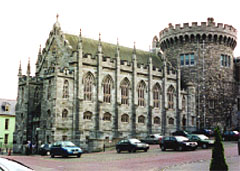
|
|
Dublin Castle
|
A short walk from the cathedral is Dublin Castle,
which actually sits on the site of the original prehistoric
settlement of Dubh Linn. The River
Poddle now flows underground. The junction of
this and the River Liffey forms a natural boundary
on two sides, and it�s believed that a Gaelic ringfort
was originally here to defend the settlement. King
Turgesius and his settlers were expelled by the local
Irish, but seventeen years later a much larger force
came led by King Olaf the White. He established a
settlement on the site of Dublin Castle, and built a
great fortress and palace. The area from here down
to Merchants Quay became a huge Viking settlement,
which they used as a base for raids and for
trading their plunder. It was from this point on that
the city began to grow significantly and became
known as the Viking kingdom of Dyflinn, which
stretched all along this coastline from present day
north County Dublin through to County Wicklow.
The Vikings were eventually defeated in The
Battle of Clontarf on Good Friday 1014. They
remained in the area until finally being driven out
completely by the invasion of the Normans, who
built a wooden Motte that was the predecessor of
Dublin Castle.

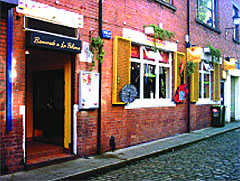
|
|
|
The Temple Bar area of Dublin is loaded with great restaurants,
music and nightlife of a more modern flavor.
|
|
This area of Dublin is by far the most interesting to
walk around in. The tourist office has a leaflet that
outlines three good walks around Medieval Dublin,
taking in all of this. This area is also great for eating
and drinking. There is a wealth of good pubs and
restaurants. The most popular section, which is hailed
as the cultural capitol of Dublin, is Temple Bar.
Nowadays it is mostly a haunt for stag parties, and
much of the culture is now just a case of getting as
drunk as possible. It is also extortionately expensive.
However, there is a great little Spanish restaurant
called La Paloma here where I ate with my girlfriend a
couple of years back. After the meal though, we elected
to get out of Temple Bar and go find a more traditional
spot. We passed a little pub called The Celt
Bar, and decided to pop in there for a drink. The beer
was good and the place was quite lively. �Good
enough,� I thought. And it was.

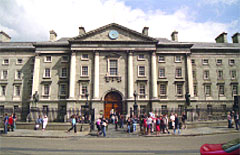
|
|
|
The magnificent fa�ade of Regent House, which presides over the
west entrance of the Trinity College campus.
|
|
Next to the National Museum and St. Patrick�s
Cathedral, Trinity College rounds out the trinity of
�must-see� destinations in County Dublin. Trinity
College lies south of the center of Dublin, just south
of the Liffey and just west of the Pearce and Tara
Street train stations. The college, besides being a
major university of international renown, with over
13,000 faculty and staff, is also a major tourist attraction
with over half a million visitors per year. And
though it offers much to the visitor, including a special
walking tour of Dublin and a major multimedia
presentation known as �The Dublin Experience�, by
far the most well-known and celebrated feature of the
Trinity College experience is the famed Book of Kells.

The tiny island of Iona, which lies off the west coast
of Scotland amongst the Inner Hebrides, is the birthplace
of one of Christianity�s most famous artifacts:
The Book of Kells. Now kept in the Trinity College
library along with a host of other ancient manuscripts, The Book of Kells is a lavishly illustrated, illuminated
manuscript containing the four Gospels of
Matthew, Mark, Luke and John that was written
around AD 800. However, this is not just any religious
book � it is also an incredible example of
Celtic art, and a truly stunning piece of work by any
measure. It is written on vellum and contains a Latin
text of the Gospels in insular majuscule script accompanied
by numerous, full-page decorative panels with
smaller painted decorations appearing throughout the
text.
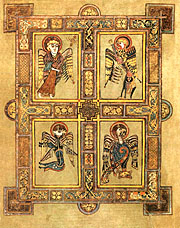
|
|
�The Four Evangelists� (folio 27v) from The Book of Kells. The
book is on display year-round in the Old Library at Trinity
College, though only two Gospels are available for viewing at any
given time, and only one page of each is on display on any given
month�one to display a major illuminated page, and the other to
show two pages of script. Image courtesy Trinity College.
|
The Old Library is also home to an exhibition with
The Book of Kells as its centerpiece, along with other
ancient manuscripts obtained by the college over the
years. I picked my way through all the students sitting
on the large, green lawn outside the building and
made my way to the entrance. Two large banners
advertised the exhibition: �The Book of Kells:
Turning Darkness into Light.� The reception area also
has a souvenir shop with an interesting selection of
books on ancient and Celtic Ireland. I joined the very
long queue to the reception desk where you can buy
your tickets. Then I was directed into the first room,
where pictures and words charted the history of the
various books owned by the library.
Nothing can prepare you for the spectacle of
actually gazing down upon this masterpiece that is
over 1,200 years old. The book was donated to
Trinity College in the 17th century, and then was
repaired and rebound into four volumes by Roger
Powell in 1953 for easier display and maintenance,
though it has been on display in the Old Library
since the 19th century. In a cabinet there are
always two Gospels on display, and the other two
are kept elsewhere for safe keeping. When I was
there, the book was open at the portrait of St. John.
It shows him sitting on a throne, book in one hand
and writing quill dipped in ink in the other. The
other volume was open at a page of text, with distinctive
rounded letters. The first letter of a paragraph
is often interlaced with smaller illustrations.
There are 340 pages in total, and all but two of the
surviving pages contain elaborate illustrations.
Thirty-one of these pages are fully illustrated in
red, purple and emerald-green color. The exquisite
rareness (and expense) of the inks used in the manuscript
have, by their very existence in the text,
proven that Ireland must have had trade links that
spanned most of the known world at that time. It�s
believed that several artists worked on these, and it
was possibly completed over a long period of time.
Tradition says that the manuscript was begun
on the Scottish isle of Iona, where St. Colmcille
lived during his exile from Ireland in the 6th century.
Historians date the book to the 8th century,
but some believe that it was as early as the 7th.
Some believe that St. Colmcille himself had a
hand in producing the book, but it�s more likely
that the monastery he set up in Iona and his tireless
missionary work was the inspiration for the
book.
In the 9th century Iona was subject to frequent
Viking raids and so the book was moved to
Colmcille�s monastery in Kells, and production was
completed there. Given the incredible detail
involved I could well believe that it might have
taken two or three centuries to complete.

From the display
room I ventured up
a flight of stairs and
emerged through a
door to the breathtaking
sight of the
Long Room. This is
the heart of the
great library, and is
like something out
of an old movie. A
narrow, polished
wooden floor stretches
out before
you into the distance
with recesses
sectioned off either
side. Each section
contains bookshelves
twice the height of the average person.
There are two levels, and an arched, wood-beamed
ceiling emphasizes the height of the room. As I
walked, intimidated as my footsteps echoed throughout
the cavernous hall, I half expected to see a huge
letter �X� emblazoned on a tile in the center of the
floor.

Access to the bookshelves is forbidden, but along
the center is a display of some of the library�s best
and most treasured books. Most prominently on display
is Brian Boru�s Harp, a magnificent wooden
harp given to the college in the 18th century.
Legend has it that this harp belonged to the High
King Brian Boru, who apparently died during The Battle of Clontarf in 1014. However, the harp has
since been dated to the 15th century, some 400 years
after the time of Brian Boru.
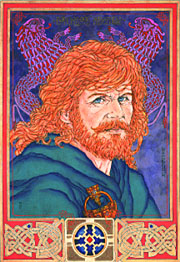
|
|
|
Brian Boru, �The Emperor of the Irish�, AD 942-1014.
Brian Boru is considered to be the greatest king in Irish history.
� 1987 Jim Fitzpatrick.
|
|
Since its creation, the harp is believed to have
had quite an interesting history. It had traveled to
Rome where it had been preserved by the Popes for
a number of years, and then back again, passing
through many hands until it was sold to one Lady
Henley �for twenty lambs and as many ewes�. It then
passed though more hands until it ended up under
the care and protection of Trinity College around
1760. There it has been ever since, given the proper
care and respect it deserves.
I had learned that Clontarf lies in the north of
County Dublin, and planned to head up there to find
out more about this man Brian Boru, whose name
seemed to keep popping up. A plaque next to the harp
claimed that there
was no evidence
linking this harp to
the king, but that it
was at least 500
years old. Wherever
it came from, it certainly
was a beautiful
piece of woodwork,
and I found it
the most interesting
exhibit in the room.
Back downstairs
in the reception area
I browsed through
the bookshop before
heading off on the
next leg of my journey:
North Dublin.

Click here to join Ian in his continuing journey to rediscover mysterious Ireland!
The Beginning
|
The National Museum
|
Dublin Town
|
Temple Bar
|
Trinity College
Notes
|
Ireland Links
|
Ireland Books
|
Ireland Audio
|
Ireland Video
|

